With a well-known spruce edge
For more than a century, Royal Copenhagen has created magical Christmas plates that spread Christmas spirit and coziness in homes around the world. Each Christmas plate is a small work of art in itself, hand-painted and decorated by skilled artists with beautiful motifs, from snowy landscapes and wintry scenes to Christmas trees and festive traditions - each motif tells a unique story and evokes memories of cozy Christmas moments!
The classic Royal Copenhagen Christmas plates are characterized by the blue and white colors and are often associated with the spruce edge that became a permanent part of Royal Copenhagen's Christmas plate's design in 1941. However, Royal Copenhagen has also released other series of Christmas plates, including Peter's Christmas, the Children's Christmas, and Christmas in Denmark Xmas Plates.
The classic blue Christmas plates from Royal Copenhagen are still being released to this day and can be found among their annual Blue Collectibles collections.
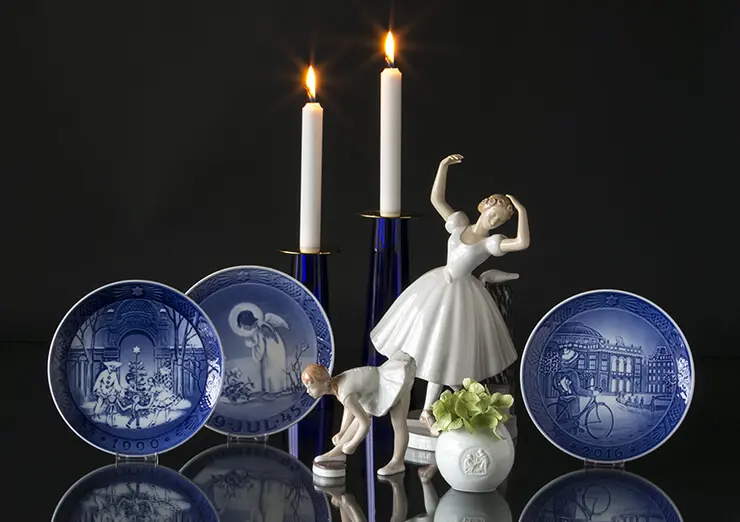
The story of Royal Copenhagen's Christmas plates
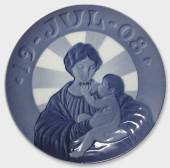
The first Royal Copenhagen Christmas wall plate was issued in a tiny edition in 1908 to test the interest. - This was 13 years after the world's first porcelain Christmas plate was produced by Bing & Groendahl. The Christmas plate was warmly received and since then a Christmas plate have continuously been produced every year.
Royal Copenhagen, then known as the Royal Porcelain Factory, which was owned by Philip Schou from 1882, had engaged Adolph Clement, who was a very skilled chemist, and architect Arnold Krogh as director in 1883 and 1885, respectively. Together, these two developed the underglaze technique in such a way that it was possible to produce Royal Copenhagen's first Christmas plate in the characteristic blue shades in 1908.
The spruce edge, as we know it from Christmas plates today, have been the same on all of the decorative Christmas wall plates since 1941, but experiments with edges have been done much earlier.
Already on the Christmas plate from 1909, there is an edge consisting of summer flowers and angels. In 1911, we have a real spruce branches with cones and in 1915 we see the edge as it looks today.
Then there were experiments with different edges and throughout the 1920s and 1930s the edge took more and more shape, until in 1941 it became the one we know today.
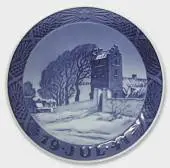 In the 1960's and 1970's there were Royal Christmas wall plates in almost every Danish home, either as decoration on the walls or as savings in the attic. Unfortunately the interest in the Royal Copenhagen Christmas plates decreased in the following years and these years does not have the same high commercial value as some of the others.
In the 1960's and 1970's there were Royal Christmas wall plates in almost every Danish home, either as decoration on the walls or as savings in the attic. Unfortunately the interest in the Royal Copenhagen Christmas plates decreased in the following years and these years does not have the same high commercial value as some of the others.
In 1987 the Royal Porcelain Factory merged with Bing & Grondahl Porcelain Factory and thus arose the name Royal Copenhagen in Denmark. Abroad the Royal Danish Christmas wall plates have always been known as Royal Copenhagen Christmas plates.
Among the latest Royal Copenhagen Christmas plates, which like previous plates attempt to describe the Danish Christmas and holiday spirit, is the 2008 Royal Copenhagen Christmas plate, released in the 100th year since the release of Royal Copenhagen's first Christmas plate in 1908. The 2008 Christmas plate, designed by Sven Vestergaard, connects back to the Royal Copenhagen Christmas plate of 1908, as the radiance seen behind Mary with the child on the 1908 plate is repeated in the 2008 Royal Copenhagen Christmas plate, where Sven Vestergaard has chosen to place the radiance behind Copenhagen's towers.
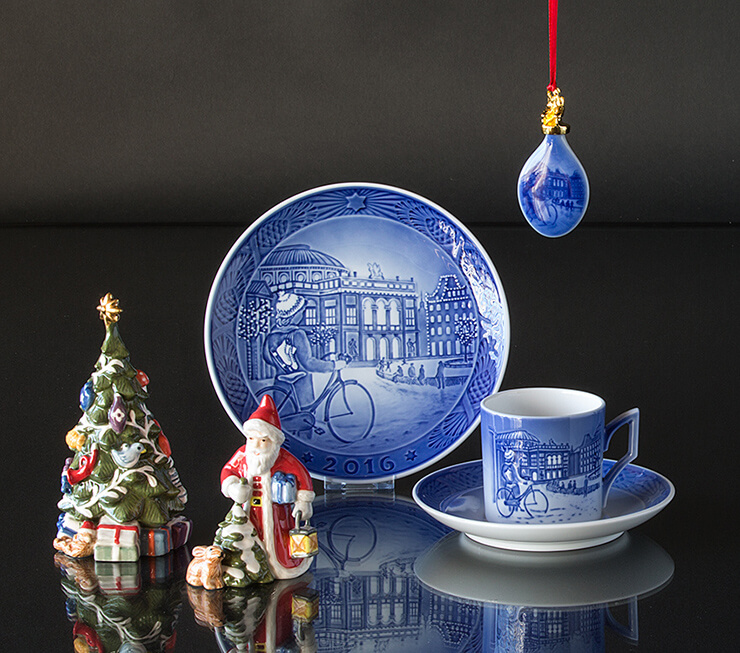
How are the Christmas plates used today?
The Royal Copenhagen Christmas plates can still be used in many ways! In addition to being decorative on the wall, as they always have been, they have acquired some more uses.
Today the Royal Copenhagen Christmas plates are also used as dishes for Christmas parties, dessert plates for rice pudding or cake plates for your festivities. - If you cover your Christmas table with a white, red or blue tablecloth the Royal Copenhagen Christmas plates fit beautifully. Along with white porcelain, they provide a beautiful contrast to the main tableware and is a beautiful reminder of tradition and Christmas through the ages, which has been a central part of our consciousness around Christmas.
In combination with the Royal Copenhagen Christmas cups, you can set a unique coffee table. In 1979 Royal Copenhagen started the tradition of making a Christmas cup and saucer with the same motif as the Christmas plate of the year. It gives you the possibility of setting a coffee table with the Royal Copenhagen Christmas Service, together with a coffee pot, sugar bowl, creamer and candlesticks.
Can the Christmas plates be used for serving food?
The blue Danish Christmas plates are decorated under the glazing, which means that they can be used for serving food and to eat from. The plates are perfect decorations for both wall and table and with these old blue Christmas plates you can be sure to set a Christmas table that will amaze and amuse your friends.
If you serve on the plate the motif will slowly emerge as the food is eaten revealing the wonderful image below in a slow fashion piece by piece giving the whole seance and extra dimension. This is especially true, if you have a set of plates with different images on them. Then every guest will have his or her own unique motif, when finished eating and if combined with the Christmas cups and saucers the whole thing could get an extra dimension.
If games are to be played, serving the food directly on the plate with the hidden motif, without matching it to the cup and saucer, provides a fun way to pair up in groups. Each person with a plate motif can be matched with someone who has the corresponding cup motif.
Can Christmas plates go in the dishwasher?
Yes, Royal Copenhagen Christmas plates are underglaze decorated and therefore suitable for the dishwasher. This applies to all the blue painted Danish Christmas plates. However, foreign Christmas plates with color prints will over time wear off the color prints.
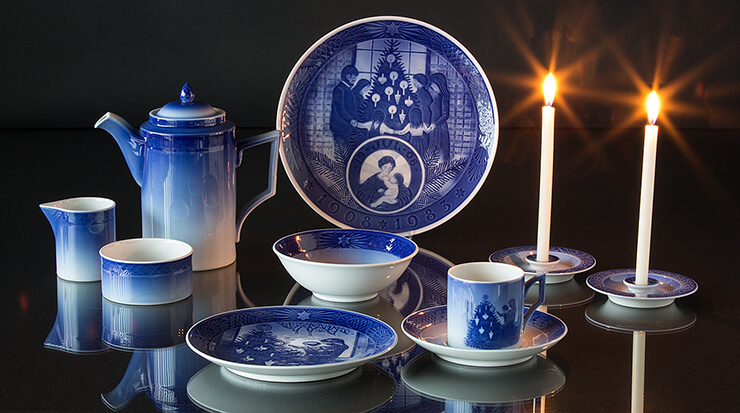
Produced and destroyed
Royal Copenhagen's first Christmas plate was only produced in 1908, and the tradition of only producing the Christmas plate in the year of its release has been followed ever since. The mould for each year's Christmas plate is destroyed, when the year comes to an end, and the plate can never be reproduced. This fact has made Royal Copenhagen Christmas plates from some years scarce, and especially the 1908 Royal Copenhagen Christmas plate, which was produced in a very limited number as Royal Copenhagen had no way of anticipating the success of the Christmas plate, is in very high demand by collectors all over the world.
The Royal Copenhagen 1908 Christmas plate is titled Madonna with Child and the motif is of the Virgin Mary with the baby Jesus. Christian Thomsen designed this first Royal Copenhagen Christmas plate in the well known blue nuances. The following years, Royal Copenhagen engaged a number of very talented designers to add their contribution to the motif of the Royal Copenhagen Christmas plate.
At the beginning the designers of the Christmas plates varied from year to year, but one of the designers among the first Christmas plates is Oluf Jensen. Since the mid-1960's Kaj Lange was a steady designer of the blue Christmas plates. In 1986, Sven Vestergaard took over and he designed the Royal Copenhagen Christmas plates until 2015. Since then Allan Therkelsen has designed the Christmas plates.
Overview of the different designers of the Christmas plates:
Christian Thomsen has designed the Royal Copenhagen Christmas plate 1908, 1910 and 1912
Stephan Ussing has designed the Royal Copenhagen Christmas plate 1909
Oluf Jensen has designed the Royal Copenhagen Christmas plate 1911, 1917, 1918, 1919, 1923, 1925, 1929, 1932 and 1934
Arthur Boesen has designed the Royal Copenhagen Christmas plate 1913 and 1914
Arnold Krog has designed the Royal Copenhagen Christmas plate 1915
Richard Bøcher has designed the Royal Copenhagen Christmas plate 1916, 1926, 1936, 1945 and 1951
Gotfred Rode has designed the Royal Copenhagen Christmas plate 1920, 1928 and 1931
Ellinor Selchau has designed the Royal Copenhagen Christmas plate 1922
Chr. Benjamin-Olsen has designed the Royal Copenhagen Christmas plate 1924, 1927, 1930, 1933 and 1935
Niels Thorsson (Nils Thorson) has designed the Royal Copenhagen Christmas plate 1937, 1942, 1943 and 1946
Herne Nielsen has designed the Royal Copenhagen Christmas plate 1938
Sv. Nicolai Nielsen has designed the Royal Copenhagen Christmas plate 1939
Kaj Lange has designed the Royal Copenhagen Christmas plate 1940, 1947, 1952, 1954, 1955, 1956, 1961, 1962, 1963, 1964, 1965, 1966, 1967, 1968, 1969, 1970, 1971, 1972, 1973 ,1974, 1975, 1977, 1978, 1979, 1980, 1981, 1982, 1983, 1984 and 1985
Theodor Kjølner has designed the Royal Copenhagen Christmas plate 1941, 1948 and 1953
Viggo Olsen has designed the Royal Copenhagen Christmas plate 1944 and 1950
Hans Henrik Hansen has designed the Royal Copenhagen Christmas plate 1949, 1957, 1958, 1959 and 1960
Sven Vestergaard has designed the Royal Copenhagen Christmas plate 1976, 1986, 1987, 1988, 1989, 1990, 1991, 1992, 1993, 1994, 1995, 1996, 1997, 1998, 1999, 2000, 2001, 2002, 2003, 2004, 2005, 2006, 2007, 2008, 2009, 2010, 2011, 2012, 2013, 2014 and 2015
Allan Therkelsen has designed the Royal Copenhagen Christmas plate 2016, 2017, 2018, 2019, 2020, 2021, 2022 and 2023.
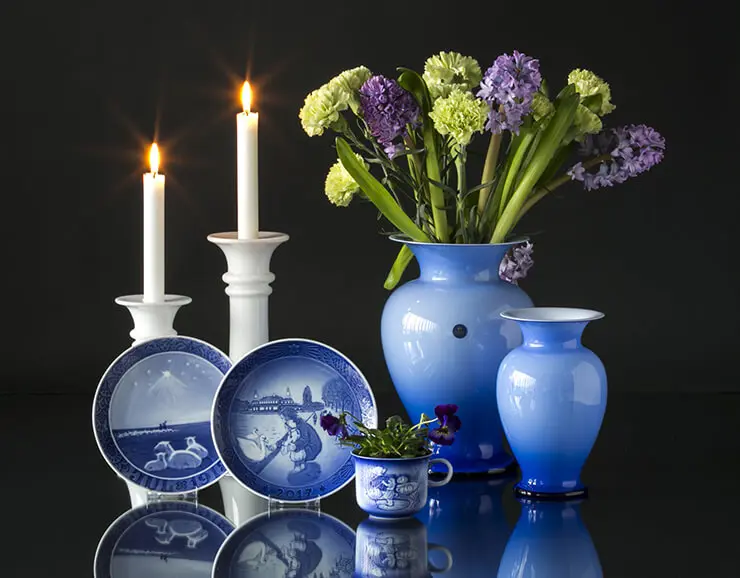
Christmas plates, what are they worth?
The above question is often asked and the answer is that it depends on which Christmas plates are being referred to. Basically, the most sought-after and valuable Christmas plates are Royal Copenhagen's, as you can see on this page, but it is still crucial which vintages are being discussed. The plates that we are looking for are Royal Copenhagen's very first Christmas plate from 1908 and especially the vintages from World War II, which are rarer and therefore more sought after in relation to the number available.
Are you interested in selling your Royal Copenhagen Christmas plates?
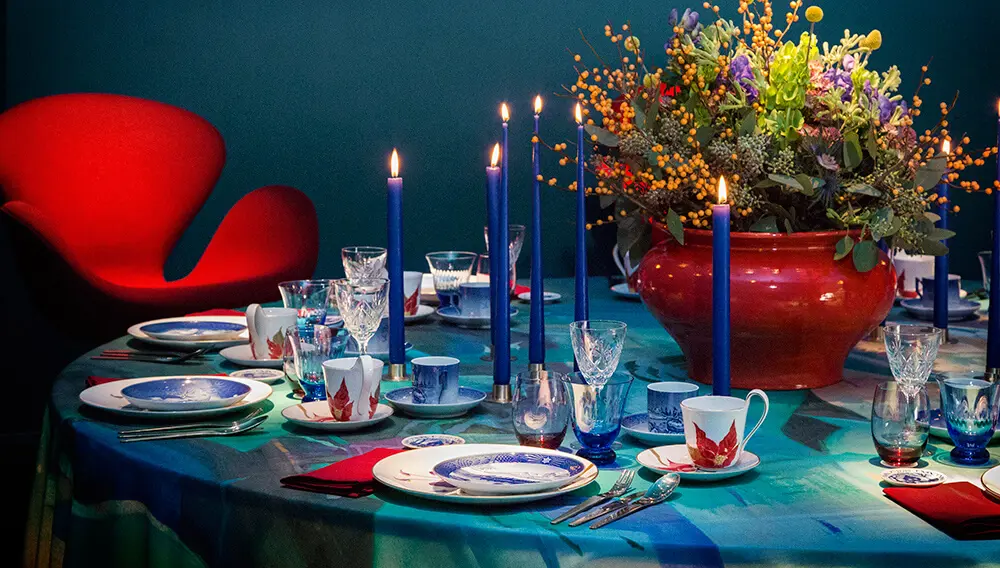
What Royal Copenhagen Christmas plates are there?
In addition to this year's Christmas plate, Royal Copenhagen has also launched other beautiful Christmas plate series.
Royal Copenhagen Christmas Plates with Foreign Inscription: Weihnachten, Vanoce, Noel, Christmas
Royal Copenhagen's Christmas plates have also been released with the word "Jul" written in a range of other languages than Danish. This was most common in the beginning, when Christmas plates with German text were produced specifically for the German market. Therefore, the Christmas plates with German text are also the most common plates with foreign text.
The production of Christmas plates with foreign text occurred during the period from 1908 to the 1920s and began again during the war years of 1940-1945. In addition to the German-language plates, there are also plates in French and Czech.
After the war, Christmas plates have been produced with Danish text, but one was produced in 1999 with Italian text.
Royal Copenhagen Peter's Christmas Plates
Royal Copenhagen released a series of eight plates inspired by the famous Christmas story "Peter's Christmas". Each of the eight plates had a verse from the story about how Peter and his family celebrate Christmas. The complete story consists of a total of 11 songs that describe the wait for Christmas, Christmas Eve itself, New Year's Eve, and Epiphany Eve, and finally the old Christmas tree being taken away after Christmas.
"Peter's Christmas" is the classic story of the Danish Christmas and was written in its current form by Johan Krohn in 1870. The story is for many the epitome of the cozy Danish Christmas as it was formed in the late 1800s with gifts and a Christmas tree.
The Christmas plates are decorated with motifs from the story's illustrations, which are by Otto Haslund and the author's brother Pietro Krohn. The edges of the plates are decorated with spruce branches and at the bottom, there is a verse from the story so that each plate has a verse that fits the illustration.
Royal Copenhagen Children's Christmas Plates
From 1998 to 2011, Royal Copenhagen released an exciting series of Christmas plates called "Børnenes Jul" (Children's Christmas). This series of Christmas plates shows motifs of children who are delighted by Christmas and are in different Christmas scenes such as nativity plays and dancing around the Christmas tree.
The series was designed by the artist Ingrid Jensen and the motifs are sweet and suitable for the children's theme. The Christmas plates are richly decorated with emphasis on the detail in the motifs.
"Børnenes Jul" is very similar to a Christmas version of the Children's Day plates from Bing & Groendahl.
Royal Copenhagen Christmas in Denmark Xmas Plates
The beloved family Christmas plate series was a colorful series of plates depicting a romanticized family Christmas from around the turn of the century, 1900. The plate series is particularly distinguished by its great colorfulness and the very clear motifs on the individual plates.
The family is shown in various classic Christmas situations such as dancing around the Christmas tree, ice skating, shopping for gifts, cozying up in the living room, and fetching the Christmas tree.
Like the Peter's Christmas plates, these Christmas plates depict a picture of the classic Christmas as one imagines it in olden days with dad and mom and the children together in the happy holiday activities.
The series ran from 1991 to 1996.
Royal Copenhagen Hearts of Christmas Plates
Between 2006 and 2010, Royal Copenhagen released a series of platters called "Hearts' Christmas". The Christmas platters in this series are very similar to those we know from our dear families, and it's not surprising since both platter series were designed by Hans Henrik Hansen.
The theme is also the classic Christmas, but here it is just two children enjoying Christmas with Santa Claus who are at the center. "Hearts' Christmas" is thus a series that celebrates children's joy of the holiday season.
See also:
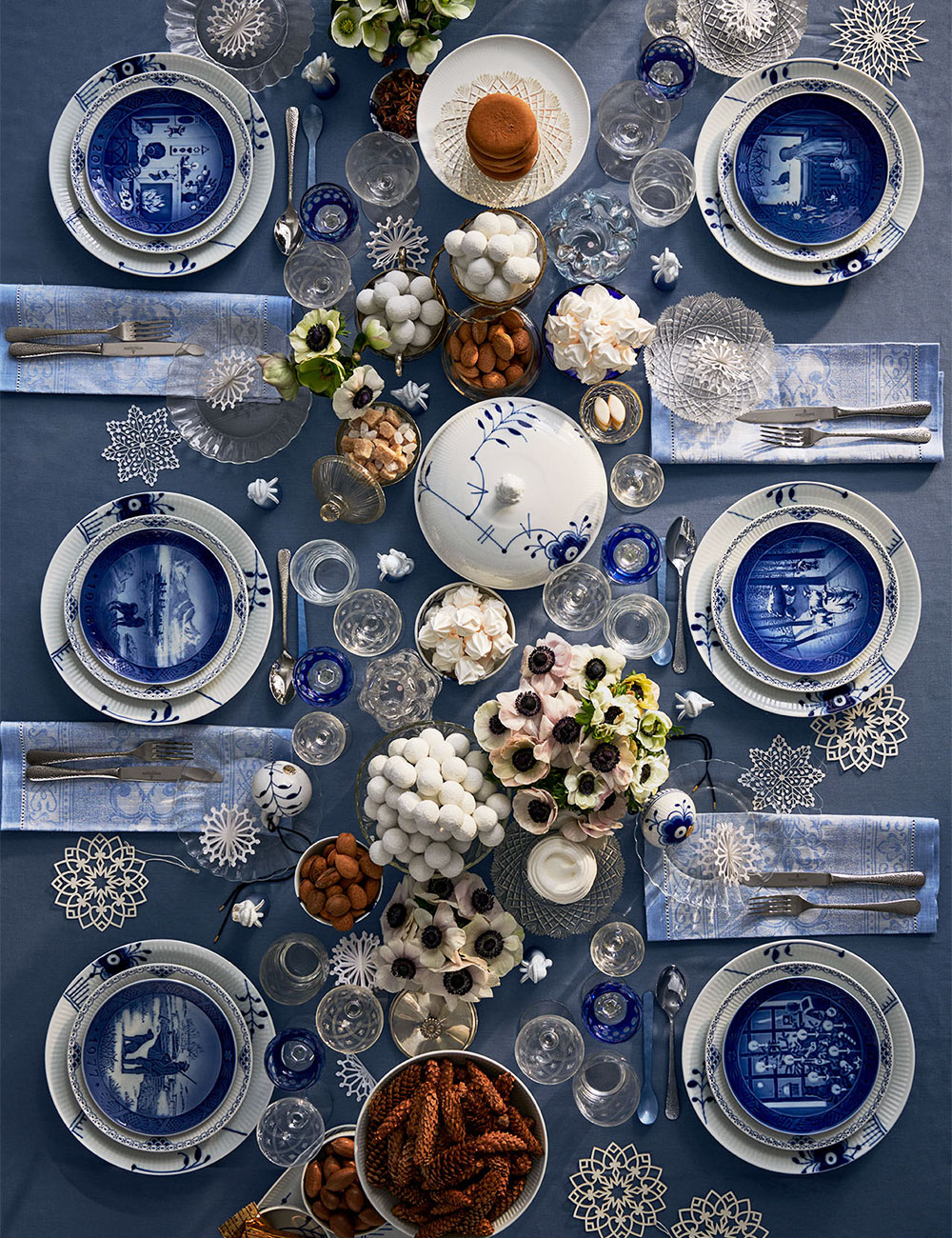
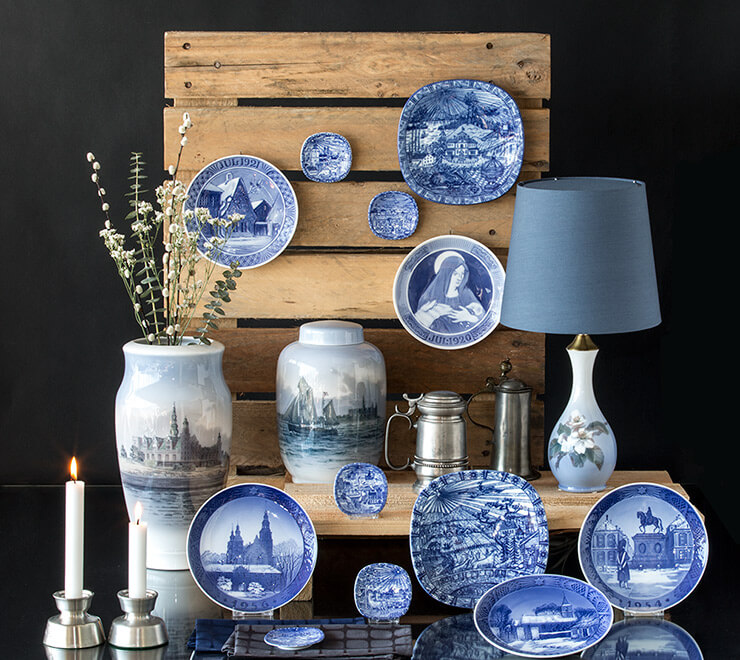
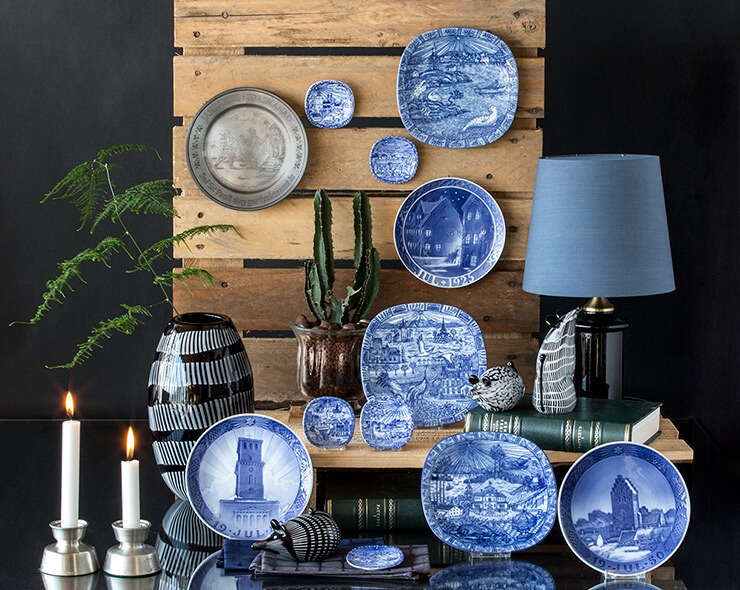
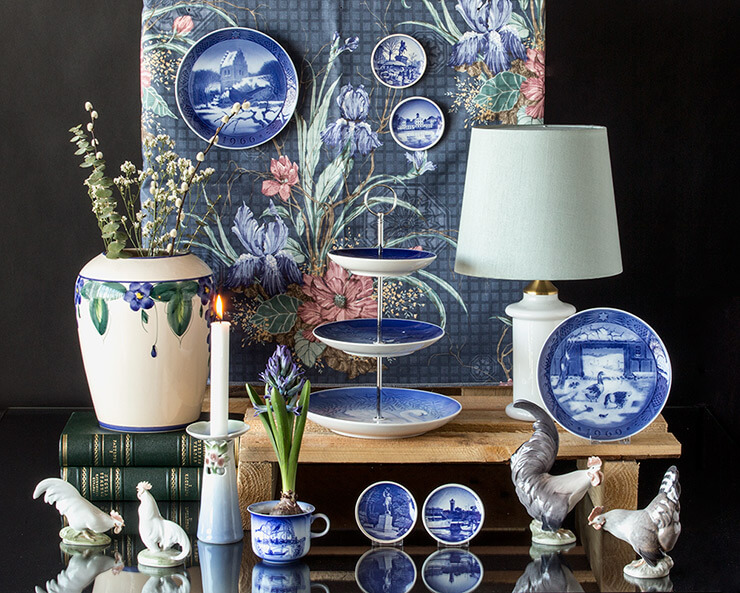


 We are e-approved
We are e-approved





